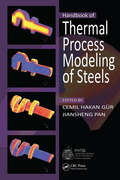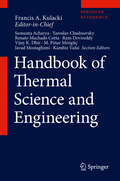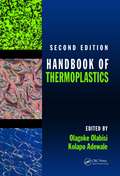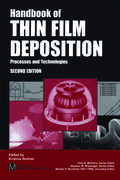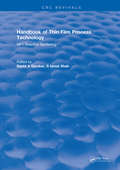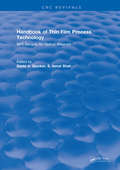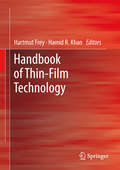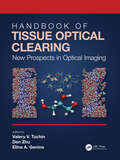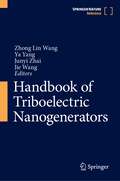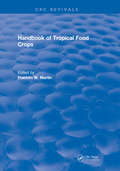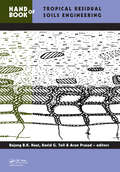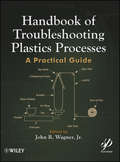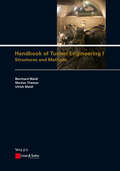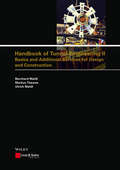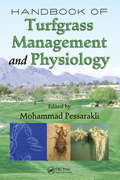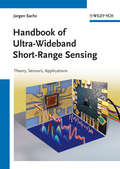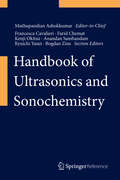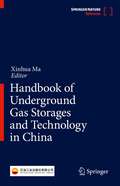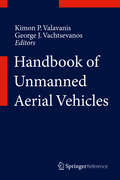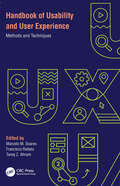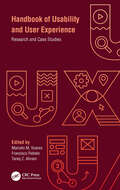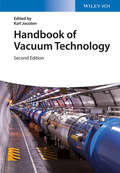- Table View
- List View
Handbook of Thermal Process Modeling Steels
by Cemil Hakan Gür Jiansheng PanAn Emerging Tool for Pioneering Engineers Co-published by the International Federation of Heat Treatment and Surface Engineering.Thermal processing is a highly precise science that does not easily lend itself to improvements through modeling, as the computations required to attain an accurate prediction of the microstructure and properties of work
Handbook of Thermal Science and Engineering
by Francis A. Kulacki Sumanta Acharya Yaroslav Chudnovsky Renato Machado Cotta Ram Devireddy Vijay K. Dhir M. Pinar Mengüç Javad Mostaghimi Kambiz VafaiThis Handbook provides researchers, faculty, design engineers in industrial R&D, and practicing engineers in the field concise treatments of advanced and more-recently established topics in thermal science and engineering, with an important emphasis on micro- and nanosystems, not covered in earlier references on applied thermal science, heat transfer or relevant aspects of mechanical/chemical engineering. Major sections address new developments in heat transfer, transport phenomena, single- and multiphase flows with energy transfer, thermal-bioengineering, thermal radiation, combined mode heat transfer, coupled heat and mass transfer, and energy systems. Energy transport at the macro-scale and micro/nano-scales is also included. The internationally recognized team of authors adopt a consistent and systematic approach and writing style, including ample cross reference among topics, offering readers a user-friendly knowledgebase greater than the sum of its parts, perfect for frequent consultation. The Handbook of Thermal Science and Engineering is ideal for academic and professional readers in the traditional and emerging areas of mechanical engineering, chemical engineering, aerospace engineering, bioengineering, electronics fabrication, energy, and manufacturing concerned with the influence thermal phenomena.
Handbook of Thermoplastic Piping System Design (Mechanical Engineering)
by Thomas Sixsmith Reinhard HanselkaOffers coverage of design, engineering, chemical resistance, costs, standards, codes and specifications. The text provides a resistance guide that lists over 800 chemicals and nearly 400 trade names cross-referenced to formal chemical names, covering all known chemical resistance data for the most popular thermoplastic piping systems. The book cove
Handbook of Thermoplastics (Plastics Engineering)
by Olagoke Olabisi Kolapo AdewaleThis new edition of the bestselling Handbook of Thermoplastics incorporates recent developments and advances in thermoplastics with regard to materials development, processing, properties, and applications. With contributions from 65 internationally recognized authorities in the field, the second edition features new and updated discussions of seve
Handbook of Thin Film Deposition Techniques Principles, Methods, Equipment and Applications, Second Editon
by Krishna SeshanThe Handbook of Thin Film Deposition Techniques: Principles, Methods, Equipment and Applications, Second Edition explores the technology behind the spectacular growth in the silicon semiconductor industry and the continued trend in miniaturization over the last 20 years. This growth has been fueled in large part by improved thin film deposition tec
Handbook of Thin Film Process Technology: 98/1 Reactive Sputtering
by David A GlockerThe Handbook of Thin Film Process Technology is a practical handbook for the thin film scientist, engineer and technician. This handbook is regularly updated with new material, and this volume is a special issue on reactive sputtering which will be of interest to a wide range of industrial and academic researchers in addition to owners of the main Handbook. Some recent developments in the reactive sputtering field are covered, including unbalanced magnetron sputtering and pulsed reactive sputtering. The articles contain a wealth of practical information relating to applications, practice and manufacturing techniques.
Handbook of Thin Film Process Technology: 98/2 Recipes for Optical Materials
by D GlockerThe Handbook of Thin Film Process Technology is a practical handbook for the thin film scientist, engineer and technician. This handbook is regularly updated with new material, and this volume presents additional recipe-type information (i.e. important deposition system details and process parameters) for optical materials.
Handbook of Thin-Film Technology
by Hartmut Frey Hamid R. Khan"Handbook of Thin Film Technology" covers all aspects of coatings preparation, characterization and applications. Different deposition techniques based on vacuum and plasma processes are presented. Methods of surface and thin film analysis including coating thickness, structural, optical, electrical, mechanical and magnetic properties of films are detailed described. The several applications of thin coatings and a special chapter focusing on nanoparticle-based films can be found in this handbook. A complete reference for students and professionals interested in the science and technology of thin films.
Handbook of Tissue Optical Clearing: New Prospects in Optical Imaging
by Valery V. Tuchin, Dan Zhu, and Elina A. GeninaBiomedical photonics is currently one of the fastest growing fields, connecting research in physics, optics, and electrical engineering coupled with medical and biological applications. It allows for the structural and functional analysis of tissues and cells with resolution and contrast unattainable by any other methods. However, the major challenges of many biophotonics techniques are associated with the need to enhance imaging resolution even further to the sub-cellular level as well as translate them for in vivo studies. The tissue optical clearing method uses immersion of tissues into optical clearing agents (OCAs) that reduces the scattering of tissue and makes tissue more transparent and this method has been successfully used ever since. This book is a self-contained introduction to tissue optical clearing, including the basic principles and in vitro biological applications, from in vitro to in vivo tissue optical clearing methods, and combination of tissue optical clearing and various optical imaging for diagnosis. The chapters cover a wide range of issues related to the field of tissue optical clearing: mechanisms of tissue optical clearing in vitro and in vivo; traditional and innovative optical clearing agents; recent achievements in optical clearing of different tissues (including pathological tissues) and blood for optical imaging diagnosis and therapy. This book provides a comprehensive account of the latest research and possibilities of utilising optical clearing as an instrument for improving the diagnostic effectiveness of modern optical diagnostic methods. The book is addressed to biophysicist researchers, graduate students and postdocs of biomedical specialties, as well as biomedical engineers and physicians interested in the development and application of optical methods in medicine. Key features: The first collective reference to collate all known knowledge on this topic Edited by experts in the field with chapter contributions from subject area specialists Brings together the two main approaches in immersion optical clearing into one cohesive book
Handbook of Transition Metal Polymerization Catalysts
by Ray HoffIncluding recent advances and historically important catalysts, this book overviews methods for developing and applying polymerization catalysts – dealing with polymerization catalysts that afford commercially acceptable high yields of polymer with respect to catalyst mass or productivity.• Contains the valuable data needed to reproduce syntheses or use the catalyst for new applications• Offers a guide to the design and synthesis of catalysts, and their applications in synthesis of polymers • Includes the information essential for choosing the appropriate reactions to maximize yield of polymer synthesized• Presents new chapters on vanadium catalysts, Ziegler catalysts, laboratory homopolymerization, and copolymerization
Handbook of Transparent Conductors
by David S. Ginley Hideo Hosono David C. PaineTransparent conducting materials are key elements in a wide variety of current technologies including flat panel displays, photovoltaics, organic, low-e windows and electrochromics. The needs for new and improved materials is pressing, because the existing materials do not have the performance levels to meet the ever- increasing demand, and because some of the current materials used may not be viable in the future. In addition, the field of transparent conductors has gone through dramatic changes in the last 5-7 years with new materials being identified, new applications and new people in the field. "Handbook of Transparent Conductors" presents transparent conductors in a historical perspective, provides current applications as well as insights into the future of the devices. It is a comprehensive reference, and represents the most current resource on the subject.
Handbook of Triboelectric Nanogenerators
by Zhong Lin Wang Jie Wang Ya Yang Junyi ZhaiThis handbook comprehensively covers the rapidly evolving field of power generation using triboelectric nanogenerators. Since their emergence in 2012, triboelectric nanogenerators have experienced fast development both in fundamental science aspects and technological innovations resulting in a plethora of outstanding applications and commercial opportunities in e.g. micro-nano energy systems, self-powered sensors, blue energy, and high-voltage power sources.The Handbook of Triboelectric Nanogenerators provides an indispensable overview of the state of the art in the field. It begins with a review of the physical and technological fundamentals and provides detailed coverage of triboelectric nanogenerators for cutting-edge applications from wearable electronics and medical implants to smart home sensing devices and human–machine interfacing.Edited and authored by active researchers in the field, the handbook offers a wealth of information for applied physicists and chemists, as well as materials scientists and engineers. In addition, mechanical and electronic engineers working in the fields of energy scavenging, power sources, and sensor-related application development will benefit greatly from the technical information presented in this groundbreaking reference work.
Handbook of Tropical Food Crops
by Franklin W. MartinFirst Published in 2018. Routledge is an imprint of Taylor & Francis, an Informa company.
Handbook of Tropical Residual Soils Engineering
by Arun Prasad David G. Toll Bujang B.K. HuatResidual soils are found in many parts of the world. Like other soils, they are used extensively in construction, either to build upon, or as construction material. They are formed when the rate of rock weathering is more rapid than transportation of the weathered particles by e.g., water, gravity and wind, which results in a large share of the soi
Handbook of Troubleshooting Plastics Processes
by John R. Wagner Jr.This handbook provides a framework for understanding how to characterize plastic manufacturing processes for use in troubleshooting problems. The 21 chapters are authored by well-known and experienced engineers who have specialized knowledge about the processes covered in this practical guide. From the Preface: "In every chapter, the process is described and the most common problems are discussed along with the root causes and potential technical solutions. Numerous case studies are provided that illustrate the troubleshooting process. Mark A. Spalding, The Dow Chemical Company
Handbook of Tunnel Engineering I: Structures and Methods, 1st Edition
by David S. Sturge Bernhard Maidl Ulrich Maidl Markus ThewesTunnel engineering is one of the oldest, most interesting but also challenging engineering disciplines and demands not only theoretical knowledge but also practical experience in geology, geomechanics, structural design, concrete construction, machine technology, construction process technology and construction management. The two-volume "Handbuch des Tunnel- und Stollenbaus" has been the standard reference for German-speaking tunnellers in theory and practice for 30 years. The new English edition is based on a revised and adapted version of the third German edition and reflects the latest state of knowledge. The book is published in two volumes, with the first being devoted to more practical themes of construction and construction process in drill and blast and mechanised tunnelling. Microtunnelling and ventilation are also dealt with. All chapters include practical examples.
Handbook of Tunnel Engineering II
by Bernhard Maidl Ulrich Maidl Markus ThewesTunnel engineering is one of the oldest, most interesting but also challenging engineering disciplines and demands not only theoretical knowledge but also practical experience in geology, geomechanics, structural design, concrete construction, machine technology, construction process technology and construction management. The two-volume "Handbuch des Tunnel- und Stollenbaus" has been the standard reference work for German-speaking tunnellers in theory and practice for 30 years. The new English edition is based on a revised and adapted version of the third German edition and reflects the latest state of knowledge. The book is published in two volumes, with the second volume covering both theoretical themes like design basics, geological engineering, structural design of tunnels and monitoring instrumentation, and also the practical side of work on the construction site such as dewatering, waterproofing and scheduling as well as questions of tendering, award and contracts, data management and process controlling. As with volume I, all chapters include practical examples.
Handbook of Turfgrass Management and Physiology
by Mohammad PessarakliA multibillion dollar industry that has tripled in the last ten years, turfgrass management plays an important role in landscaping, golf courses, and other sports surfaces. Proper management and cultural practices are crucial for the performance of these versatile grasses, creating a demand among scientists, researchers, and industry professionals
Handbook of Ultra-Wideband Short-Range Sensing
by Jürgen SachsRanging from the theoretical basis of UWB sensors via implementation issues to applications, this much-needed book bridges the gap between designers and appliers working in civil engineering, biotechnology, medical engineering, robotic, mechanical engineering, safety and homeland security.From the contents:* History* Signal and systems in time and frequency domain* Propagation of electromagnetic waves (in frequency and time domain)* UWB-Principles* UWB-antennas and applicators* Data processing* Applications
Handbook of Ultrasonics and Sonochemistry
by Muthupandian AshokkumarThe aim of this handbook is to summarize the recent development in the topic of ultrasonics and sonochemistry, especially in the areas of functional materials and processing applications. This handbook will benefit the readers as a full and quick technical reference with a high-level historic review of technology, detailed technical descriptions and the latest practical applications. This handbook is divided into five main sections: fundamentals of ultrasonics and sonochemistry, biomaterials, food processing, catalysts, wastewater remediation. Each section and chapter is written by reputable international scholars and industrial experts. The handbook comprehensively covers the fundamentals of sonochemistry along with key applications. The handbook strives to be a self-contained, easily-understandable reference that will also include up to date knowledge based on research articles. This handbook serves to provide a quick and reliable knowledge for new comers from chemistry, bioengineering, food processing, environmental engineering, in both academia and in industrial fields.
Handbook of Underground Gas Storages and Technology in China
by Xinhua MaThis book summarizes achievements and technology of China's underground gas storage in the past 20 years based on years of experience and technology accumulated in the construction and operation of gas storages. It also analyses and projects the future construction of underground gas storages in China Readers can systematically understand the construction status of China's underground gas storages, the difficulties encountered and the process and solution to such difficulties. It provides important theoretical and technical guidance for both in China and the world. Features of this book are listed as 1. Understand the development history, construction status, development trend of the underground gas storages around the world with countries and regions listed as case studies. 2. Understand the market demand of China's underground gas storages and resource distribution. 3. Understand the underground gas storages already built in China. 4. Understand the integrity management and risk control of the gas storages in China. 5. Understand the operation and management mode of gas storage. The target audience are those engaging in the research and technical management of the underground gas storage. It’s a valuable reference for both reseachers and college students as well in the fields of underground storage of carbon dioxide (CO2) and helium (He), Power to Gas energy accumulation.
Handbook of Unmanned Aerial Vehicles
by Kimon P. Valavanis George J. VachtsevanosThe Handbook of Unmanned Aerial Vehicles is a reference text for the academic and research communities, industry, manufacturers, users, practitioners, Federal Government, Federal and State Agencies, the private sector, as well as all organizations that are and will be using unmanned aircraft in a wide spectrum of applications. The Handbook covers all aspects of UAVs, from design to logistics and ethical issues. It is also targeting the young investigator, the future inventor and entrepreneur by providing an overview and detailed information of the state-of-the-art as well as useful new concepts that may lead to innovative research. The contents of the Handbook include material that addresses the needs and 'know how' of all of the above sectors targeting a very diverse audience. The Handbook offers a unique and comprehensive treatise of everything one needs to know about unmanned aircrafts, from conception to operation, from technologies to business activities, users, OEMs, reference sources, conferences, publications, professional societies, etc. It should serve as a Thesaurus, an indispensable part of the library for everyone involved in this area. For the first time, contributions by the world's top experts from academia, industry, government and the private sector, are brought together to provide unique perspectives on the current state-of-the-art in UAV, as well as future directions. The Handbook is intended for the expert/practitioner who seeks specific technical/business information, for the technically-oriented scientists and engineers, but also for the novice who wants to learn more about the status of UAV and UAV-related technologies. The Handbook is arranged in a user-friendly format, divided into main parts referring to: UAV Design Principles; UAV Fundamentals; UAV Sensors and Sensing Strategies; UAV Propulsion; UAV Control; UAV Communication Issues; UAV Architectures; UAV Health Management Issues; UAV Modeling, Simulation, Estimation and Identification; MAVs and Bio-Inspired UAVs; UAV Mission and Path Planning; UAV Autonomy; UAV Sense, Detect and Avoid Systems; Networked UAVs and UAV Swarms; UAV Integration into the National Airspace; UAV-Human Interfaces and Decision Support Systems; Human Factors and Training; UAV Logistics Support; UAV Applications; Social and Ethical Implications; The Future of UAVs. Each part is written by internationally renowned authors who are authorities in their respective fields. The contents of the Handbook supports its unique character as a thorough and comprehensive reference book directed to a diverse audience of technologists, businesses, users and potential users, managers and decision makers, novices and experts, who seek a holistic volume of information that is not only a technical treatise but also a source for answers to several questions on UAV manufacturers, users, major players in UAV research, costs, training required and logistics issues.
Handbook of Usability and User-Experience: Methods and Techniques
by Marcelo M. Soares, Francisco Rebelo and Tareq Z. AhramHandbook of Usability and User Experience: Methods and Techniques is concerned with emerging usability and user experience in design concepts, theories and applications of human factors knowledge focusing on the discovery, design and understanding of human interaction and usability issues with products and systems for their improvement. This volume presents methods and techniques to design products, systems and environments with good usability, accessibility and user satisfaction. It introduces the concepts of usability and its association with user experience, and discusses methods and models for usability and UX. It also introduces relevant cognitive, cultural, social and experiential individual differences, which are essential for understanding, measuring and utilizing these differences in the study of usability and interaction design. In addition, the book discusses the use of usability assessment to improve healthcare, the relationship between usability and user experience in the built environment, the state-of-the-art review of usability and UX in the digital world, usability and UX in the current context, and emerging technologies. We hope that this first of two volumes will be helpful to a large number of professionals, students and practitioners who strive to incorporate usability and user experience principles and knowledge in a variety of applications. We trust that the knowledge presented in this volume will ultimately lead to an increased appreciation of the benefits of usability and incorporate the principles of usability and user experience knowledge to improve the quality, effectiveness and efficiency of consumer products, systems and environments in which we live.
Handbook of Usability and User-Experience: Research and Case Studies
by Marcelo M. Soares, Francisco Rebelo and Tareq Z. AhramThis volume of the Handbook of Usability and User Experience (UX) presents research and case studies used to design products, systems and environments with good usability and consequent acceptance, pleasure in use, good user experience, and understanding of human interaction issues with products and systems for their improvement. The book presents concepts and perspectives of UX; it also discusses methods and tools that use requirements analysis activity elicitation, recording, and analysis to guarantee a good user experience. In addition, it introduces usability and UX in the automotive industry, usability and UX in a digital interface, game design and digital media, usability and UX in fashion design, and some case studies on usability and UX in various contexts in product design. We hope that this second volume will be helpful to a larger number of professionals, students and practitioners who strive to incorporate usability and UX principles and knowledge in a variety of applications. We trust that the knowledge presented in this volume will ultimately lead to an increased appreciation of the benefits of usability and incorporate the principles of usability and UX knowledge to improve the quality, effectiveness, and efficiency of everyday consumer products, systems, and environments.
Handbook of Vacuum Technology
by C. Benjamin Nakhosteen Karl JoustenThis comprehensive, standard work has been updated to remain an important resource for all those needing detailed knowledge of the theory and applications of vacuum technology. The text covers the existing knowledge on all aspects of vacuum science and technology, ranging from fundamentals to components and operating systems. It features many numerical examples and illustrations to help visualize the theoretical issues, while the chapters are carefully cross-linked and coherent symbols and notations are used throughout the book. The whole is rounded off by a user-friendly appendix of conversion tables, mathematical tools, material related data, overviews of processes and techniques, equipment-related data, national and international standards, guidelines, and much more. As a result, engineers, technicians, and scientists will be able to develop and work successfully with the equipment and environment found in a vacuum.
